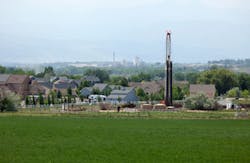How safe is unconventional oil and gas development? It has undoubtedly increased production and revolutionized the energy industry in the United States, but the practice remains controversial in many communities.
Protests over methods such as horizontal drilling, hydraulic fracturing and other drilling and well stimulation technologies often focus on how much water they use and possible links to seismic activity and water pollution. But air pollution may also be a cause for concern, according to a new study.
The research involved community sampling by people who live near production sites in five states. Findings suggest that air pollutants released by unconventional oil and gas production are well over recommended levels.
Unlike other studies that have examined contamination of ground and surface water, this one explored air quality near a range of unconventional oil and gas development and production sites that are the focus of community concern. Local residents were trained to take 'grab air' samples and collected 35 samples at 11 sites across Wyoming, Arkansas, Pennsylvania, Colorado and Ohio.
"Residents conducted sampling in response to operational conditions, odor events and a history of the onset of acute symptoms," explained lead researcher David O. Carpenter from the University at Albany in New York.
A further 41 passive tests were set up to monitor for formaldehyde near production facilities or compressor sites.
Results showed that 16 of the 35 grab sample sites and 14 of 41 passive formaldehyde tests exceeded minimal risk levels set out by the U.S. Agency for Toxic Substances and Disease Registry and the U.S. Environmental Protection Agency Integrated Risk Information System.
According to the researchers, the three chemicals that were most commonly found to exceed recommended levels and which are linked to increased risk of diseases were benzene, hydrogen sulfide and formaldehyde.
The findings of the study have been published in the open access journal Environmental Health.
